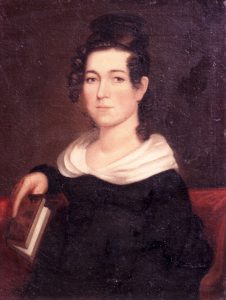George Champlin Sibley
Born: Great Barrington, Massachusetts, April 1782.
Died: St. Charles, Missouri, January 31, 1863.

The government authorized “factor,” or agent for Fort Osage, Sibley resided at the fort longer than anyone. He witnessed the founding of the fort in early September, 1808. He evacuated it in June, 1813, during the War of 1812, and returned in the fall of 1815, with his new bride Mary. Sibley also oversaw the shut-down in August, 1822, when government-sponsored Native American trade ceased and continued to reside in his home there for a few more years. Sibley directed a survey of the Santa Fe Trail in 1825, and negotiated a final treaty with the Osage before finally leaving in 1827. The Town of Sibley founded in 1836 at the location of Fort Osage bears his name.
Mary Easton Sibley

Mary Easton was born on January 24, 1800 to Mr. and Mrs. Rufus Easton in Rome, New York. In 1804, Rufus Easton moved the family to St. Louis to pursue his new appointment as the first Post Master of St. Louis in the newly acquired Louisiana Territory.
Mary completed her education at Mrs. Tivis Boarding School for Young Ladies in Shelbyville, Kentucky. Upon finishing her education she was well versed in Latin and French. At age 15, she married George Sibley the factor at Fort Osage. In 1816, the couple, along with Mary’s Sister, moved to Fort Osage.
In 1826, the Sibley’s moved to St. Charles, Missouri. It was here that Mary Sibley’s high sense of humanity led to her greatest contribution, the founding of Lindenwood College. Until her death in 1878, she took an active role in community affairs and women’s rights. Mary Sibley’s death occurred in Lindenwood where she is buried beside her husband, George Sibley.
Eli B. Clemson
Captain Eli B. Clemson (1776-1842) was the commander of the 1st U. States Infantry, which was stationed at Fort Osage from 1808 until June of 1813, when the Fort was evacuated due to the War of 1812. Before Fort Osage the newly formed Clemson’s Company was stationed at Fort Belle Fontaine near St. Louis, Missouri.
On July 17th, 1808 Captain Clemson received official orders to relocate his company to a new Fort that was to be constructed up the Missouri River. In August of 1808 Clemson’s company was ordered to escort the new Factor for the fort, George Sibley (a civilian employee of the War Department), to the location of the new fort. The fort was built in order to protect the Osage Indians and facilitate trade with them. On December 11th, 1808 Captain Clemson named the fort after the Osage Indians, the tribe the fort was built to trade with and protect.
Clemson formed an unfavorable opinion of Sibley in St. Louis, where he caused delays in their departure. Their relationship did not improve during their time at Fort Osage, where both believed they were in command. While the soldiers of the 1st Infantry were finishing up securing the fort and preparing for the first winter, Sibley was insisting that they should begin work on a larger Factory. Sibley even went as far as to write to his superiors asking that they order Clemson to start on the building. However by the time anyone back East received Sibley’s letters the fort had been completed and work had started on the Factory.
In 1810 disputes between the military and the civilians at Fort Osage began to rise. Dr. John Robinson came to Fort Osage as the Surgeons Mate, left his post to become the sutler at the Fort, and he served as an Indian sub-agent. As sutler Robinson was purportedly encouraging the soldiers to desert. It was reported that this was even going on with Sibley’s knowledge. When Clemson found out about this he immediately dismissed Robinson as the post’s sutler. After Robinson had been dismissed he immediately filed charges agents Clemson. Clemson disputed the charges, and claimed that Sibley was Robinson’s supporter. The charges were quickly dropped.
In 1812 War was declared against Great Britain. Clemson and his officers urged that Fort Osage be closed, as its distance from reinforcements left it vulnerable. By the spring of 1813 Captain Clemson had been promoted to Major and Captain John C. Symmes had been assigned to take over his company. Fort Osage was evacuated in early June of 1813.
Major Clemson was ordered to serve as the Inspector General on June 15th, 1813 and by 1814 he had been promoted Lieutenant Colonel before leaving the military.
Bibliography:
Bennett, David. Clemson and Fort Osage, October 1993.